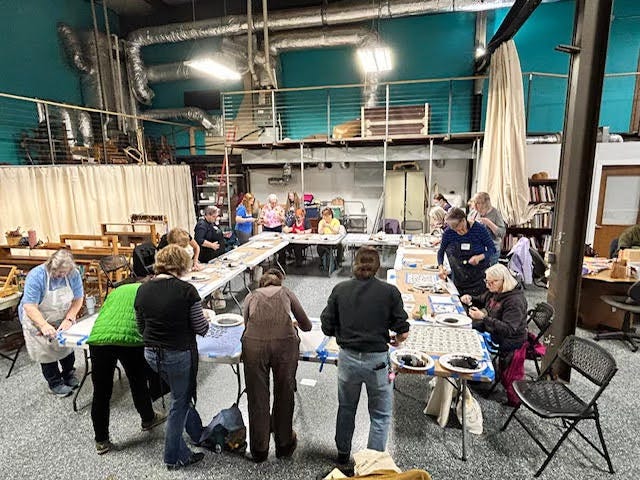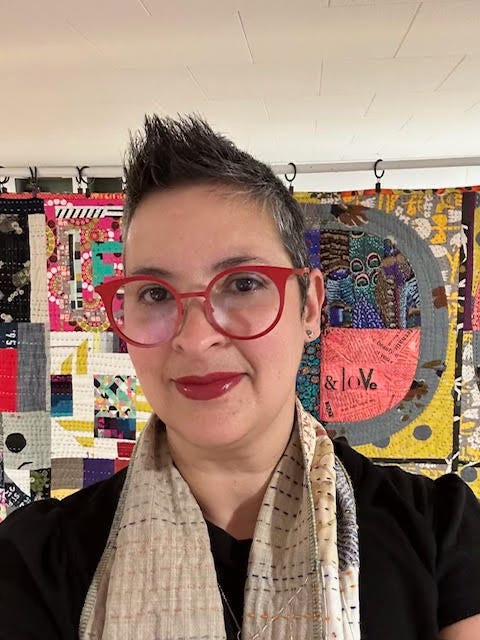A Practical and Fine Art
Community-building through sewing education in libraries with Maday Delgado.
Welcome to the fall season of IArtLibraries. Our kickoff newsletter features artist, educator, and community builder Maday Delgado. While Maday first came across my radar as a sewing educator, our conversation revealed that her connections to libraries are multifaceted and have been for a long time. Our conversation is below; please note that questions and responses have been edited and summarized in places. Enjoy~
Please introduce yourself! Tell us who you are, the kind of design and creative work that you do, and anything else you'd like to share.
I’m Maday. I was born and raised in Cuba, and came to New York City in the middle of high school. I started my college career in NYC and finished it in Wisconsin. When I was in my thirties I made a career change from banking to sewing, doing my own creative sewing work and teaching workshops and classes.
Beginning in 2015, I started donating new, basic sewing machines to public libraries. I’ve had a lot of uptake on this from libraries and other community-based organizations like the Madison Children’s Museum and the Boys and Girls Club in Baraboo.
What was the impetus or inspiration for donating sewing machines to libraries and similar places?
I want sewing education to be taken seriously. These are skills that people can use personally or professionally. Libraries are the kind of resource that can offer opportunities for skill-building and training for anyone in the community, so are a good fit for this kind of initiative.
In addition to the sewing machine donation project, Maday also partners with libraries to host workshops and classes for adults and teens.
People want to find ways to bond and find connection, I’ve seen this really take off in the last ten years. I try to help people figure out how to do things their way, and to revolutionize how sewing art is perceived – that sewing can be both practical and fine art.

Libraries are a good setting or host for experiences like this. Libraries can be spaces that unify people. No one is demanding to hear what your views are, people are generally coming to learn something new or find information they need. If we look broadly at so called “blue zones” we see that a common thread is that people in those zones collaborate with their friends, family, neighbors. Group workshops and learning experiences provide the circumstances for collaboration and learning from each other, and sewing, especially hand stitching, means that people have to slow down, be very intentional and mindful about what they’re doing.
Maday sees powerful environmental and wellbeing aspects in sewing arts, especially visible mending, which is a workshop topic she teaches regularly.
Visible mending is a metaphor for the things I’m trying to make better. Using old things to make new, beautiful, functional things, embracing continuity and circular environmental connections. I hope these workshops inspire others to try doing this in their own lives with sewing, mending and other aspects too.
As someone who partners with libraries and other cultural organizations to offer varied kinds of programming, workshops, experiences, do you have any insights, lessons learned, etc. from collaborations or partnerships that have worked particularly well in the past?
I know that libraries don’t have a ton of funding. I think about how they can help in other ways: spreading the word about workshops, resources and services that are available. I’ve found that libraries can play a crucial role in allowing artists to introduce themselves to their community. The library is the door, the space to share your work and yourself, have respectful dialogue. For artists, it’s about placemaking and space-building. Libraries can be a way to do that. We [artists] understand that this is not about money, we’re not in it for financial gain or profit. If they can, it’s appropriate for libraries to offer stipends to acknowledge and respect the work and time that the artists are putting in.
Where can people find more information about your work and offerings?
My website is Sustainable Textile Design. People can follow me on Instagram @sustainabletextiledesign and check out my newsletter and calendar.
I would also like to shout out Blue Bar Quilts in Middleton, they have been a very positive and welcoming space for me and other sewing artists. They offer community sewing workshops and do many community-based projects.




